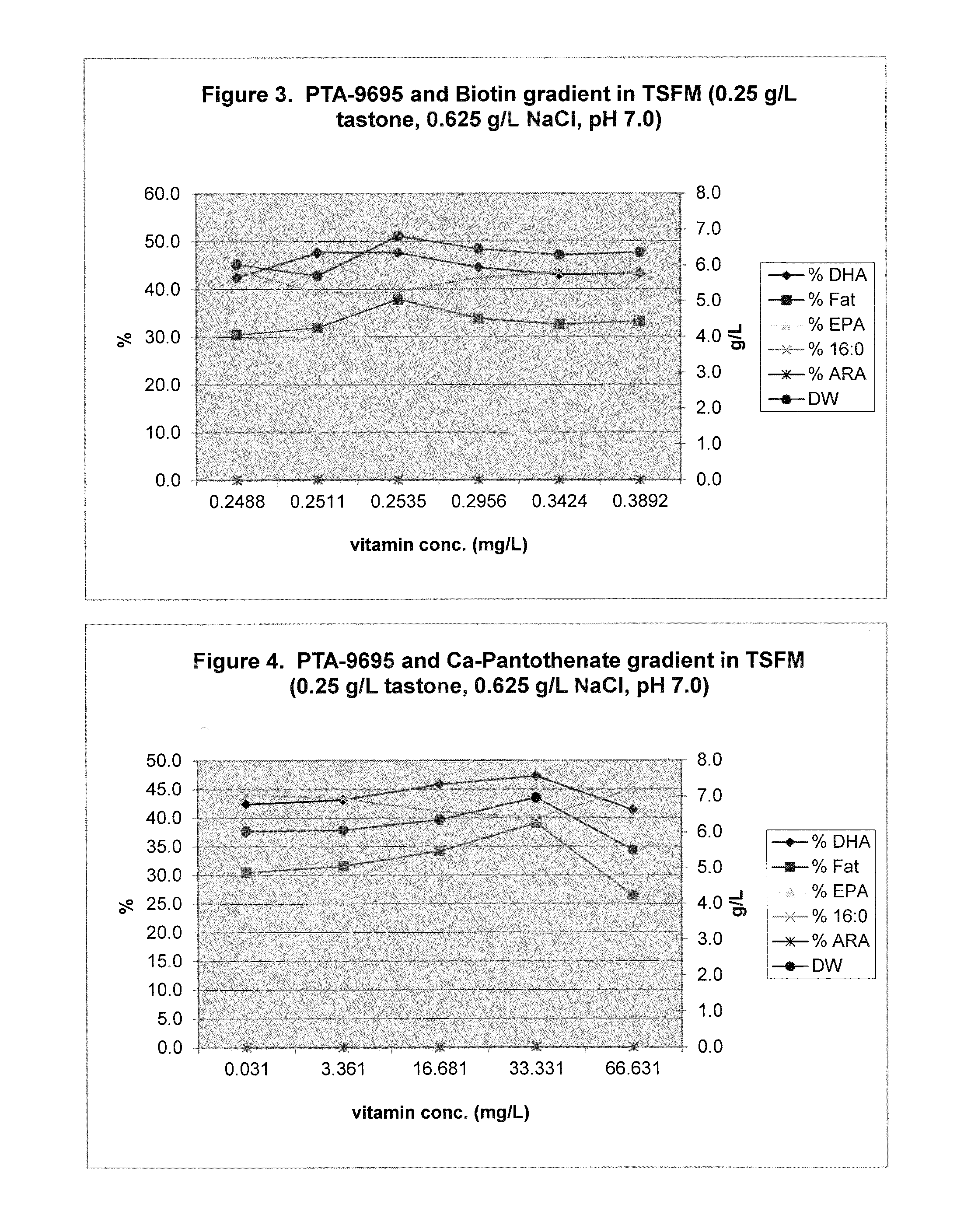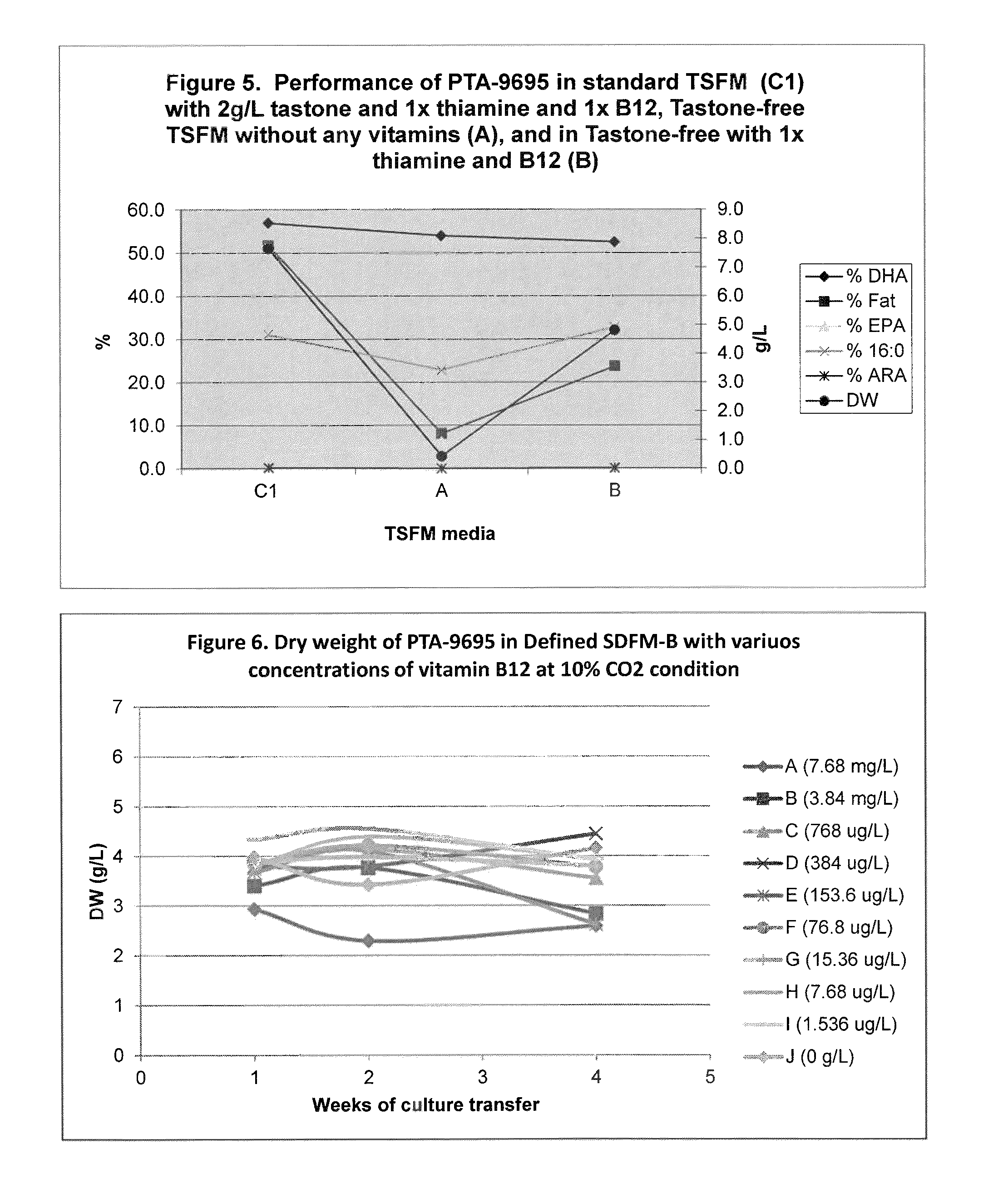Eicosapentaenoic acid-producing microorganisms, fatty acid compositions, and methods of making and uses thereof
a technology of eicosapentaenoic acid and fatty acid composition, which is applied in the field of eicosapentaenoic acid-producing microorganisms, fatty acid compositions, and methods of making and, can solve the problems of fish oil carrying the risk of environmental contaminants, slow and variable metabolic conversion rate, and fishy odor or tas
- Summary
- Abstract
- Description
- Claims
- Application Information
AI Technical Summary
Benefits of technology
Problems solved by technology
Method used
Image
Examples
example 1
[0220]In this example, Schizochytrium sp. was cultivated in 250 ml Erlenmeyer shake flasks containing 50 mls of culture medium. An inoculum was prepared in the same medium which consisted of 0.625 g NaCl, 1.0 g KCl, 5 g MgSO4.7H2O, 0.1 g (NH4)2SO4, 0.29 g CaCl2.2H2O, 1.0 g monosodium glutamate monohydrate, 1.0 g yeast extract, and 23.8 g HEPES buffer dissolved in approximately 900 mls of distilled water. The medium was brought to pH 7 using NaOH. The final volume of the medium was brought to 896 mls, and the medium was sterilized by autoclaving. After autoclaving the following components were sterilely added to the medium: 0.89 ml of 56.5 g / l KH2PO4, 100 ml of 500 g / l glucose, 2 ml of trace metal stock solution, and 1 ml of vitamin stock solution. The trace metal stock solution contained the following: 90 g citric acid, 5.15 g FeSO4.7H2O, 1.55 g MnCl2.4H2O, 0.965 g ZnSO4.7H2O, 0.02 g CoCl2.6H2O, 0.02 g Na2MoO4.2H2O, 1.035 g CuSO4.5H2O, 1.035 g NiSO4.6H2O dissolved in one liter of di...
example 2
[0222]In this example, Schizochytrium sp. was cultivated in 250 ml Erlenmeyer shake flasks containing 50 mls of culture medium. An inoculum was prepared in the same medium which consisted of 0.625 g NaCl, 1.0 g KCl, 5 g MgSO4.7H2O, 0.1 g (NH4)2SO4, 0.29 g CaCl2.2H2O, 1.0 g monosodium glutamate monohydrate, 1.0 g yeast extract, and 23.8 g HEPES buffer dissolved in approximately 900 mls of distilled water. The medium was brought to pH 7 using NaOH. The final volume of the medium was brought to 896 mls, and the medium was sterilized by autoclaving. After autoclaving the following components were sterilely added to the medium: 0.89 ml of 56.5 g / l KH2PO4, 100 ml of 500 g / l glucose, 2 ml of trace metal stock solution, and 1 ml of vitamin stock solution. The trace metal stock solution contained the following: 90 g citric acid, 5.15 g FeSO4.7H2O, 1.55 g MnCl2.4H2O, 0.965 g ZnSO4.7H2O, 0.02 g CoCl2.6H2O, 0.02 g Na2MoO4.2H2O, 1.035 g CuSO4.5H2O, 1.035 g NiSO4.6H2O dissolved in one liter of di...
example 3
[0224]In this example, Thrasutochytrium sp. was cultivated in 250 ml Erlenmeyer shake flasks containing 50 mls of culture medium. An inoculum was prepared in the same medium which consisted of 42 g Na2SO4, 0.625 g NaCl, 1.0 g KCl, 5 g MgSO4.7H2O, 0.1 g (NH4)2SO4, 0.29 g CaCl2.2H2O, 1.0 g monosodium glutamate monohydrate, 1.0 g yeast extract, and 23.8 g HEPES buffer dissolved in approximately 900 mls of distilled water. The medium was brought to pH 7 using NaOH. The final volume of the medium was brought to 961 mls, and the medium was sterilized by autoclaving. After autoclaving the following components were sterilely added to the medium: 0.89 ml of 56.5 g / l KH2PO4, 35 ml of 500 g / l glycerol, 2 ml of trace metal stock solution, and 1 ml of vitamin stock solution. The trace metal stock solution contained the following: 9 g citric acid, 5.15 g FeSO4.7H2O, 1.55 g MnCl2.4H2O, 0.965 g ZnSO4.7H2O, 0.02 g CoCl2.6H2O, 0.02 g Na2MoO4.2H2O, 1.035 g CuSO4.5H2O, 1.035 g NiSO4.6H2O dissolved in o...
PUM
 Login to View More
Login to View More Abstract
Description
Claims
Application Information
 Login to View More
Login to View More - R&D
- Intellectual Property
- Life Sciences
- Materials
- Tech Scout
- Unparalleled Data Quality
- Higher Quality Content
- 60% Fewer Hallucinations
Browse by: Latest US Patents, China's latest patents, Technical Efficacy Thesaurus, Application Domain, Technology Topic, Popular Technical Reports.
© 2025 PatSnap. All rights reserved.Legal|Privacy policy|Modern Slavery Act Transparency Statement|Sitemap|About US| Contact US: help@patsnap.com



